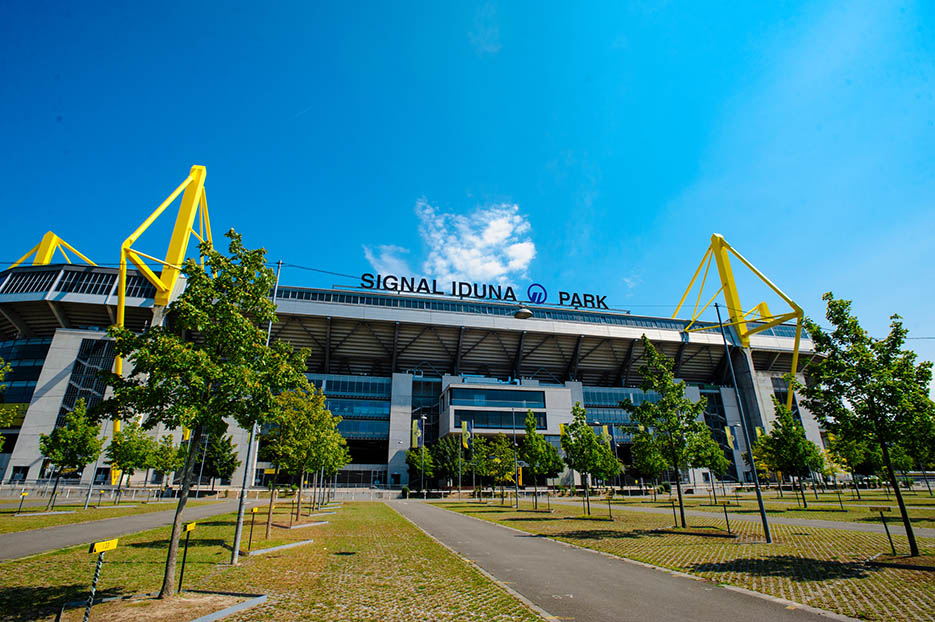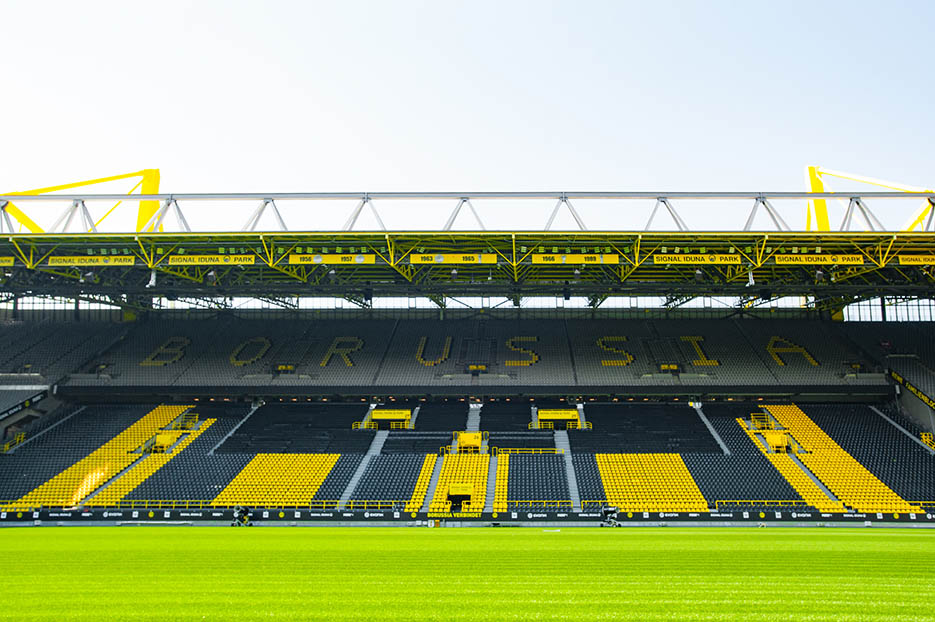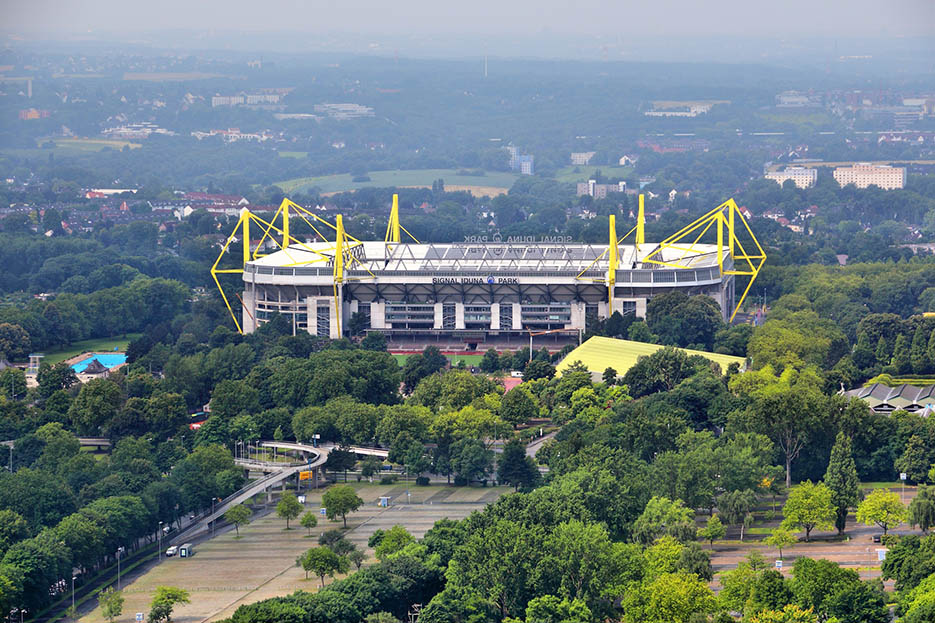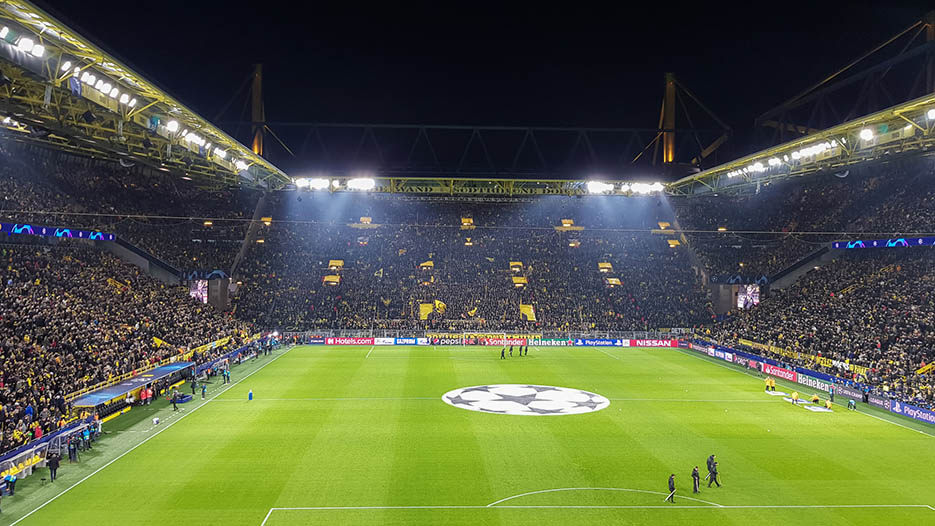Frankfurt Arena Complete Guide - Furnace Too Hot for the City
One of the Bundesliga’s most fiery stadiums will host the 2024 EURO matches - check out all you need to know in this Frankfurt Arena Complete Guide.


Ask any football fanatic to name a bucket list of football grounds to visit in your lifetime and if Westfalen isn't among them, remove the said title from their description. Borussia Dortmund's home, known now as Signal Iduna Park, is one of the top five stadiums for enjoying football. Even through a screen. So the BVB Stadion Dortmund complete guide is a must-read, especially for those lucky fans going to the Euros.
Firstly, the stadium is known as Westfalen amongst the fans, the sponsorship name is Signal Iduna Park when BVB plays on it. But for the EURO, due to UEFA regulations, it cannot bear the name of the sponsor. Hence, for the summer of 2024, it's named after the city it's located in and the famed abbreviation for the home club.
The city of Dortmund will host six EURO 2024 matches with four in the groups and two in the knockout stages.
Turkish fans will be the most numerous as their team plays two games in Group F here. With 22,000 Turks already living in Dortmund, and millions in Germany overall.
There are two open matches that have a single unknown participant at the time of writing, as they are coming from the qualification play-offs.
Italy vs Albania (Saturday, June 15th, 21:00) in Group B
Turkey vs Play-off Winner C (Tuesday, June 18th, 18:00) in Group F
Turkey vs Portugal (Saturday, June 22nd, 18:00) in Group F
France vs Play-off Winner A (Tuesday, June 25th, 18:00) in Group D
As for the play-off teams, Turkey will play one of Georgia, Greece, Luxembourg, or Kazakhstan. So a heated Turkey vs Greece derby is on the cards.
France will play a side from the A play-off path, consisting of Poland, Estonia, Wales, and Finland.
1st from Group A vs 2nd from Group C (Saturday, June 29th, 21:00) Round of 16
W47 vs W48 (Wednesday, July 10th, 21:00), semi-finals

Now about the origins of the goosebumps factory that contains the second most important wall in Germany, and is the third biggest football stadium in Europe!
Earlier in the 20th century, Borussia Dortmund was playing its games on the Stadion Rote Erde, the Red Eearth stadium. Bearing its name after the province it was in, Westphalia, known historically as Red Earth.
In 1974, the Westfalenstadion (also named after Westphalia) replaced the Rote Erde ground.
The two Borussia grounds are located immediately adjacent to each other.
BVB started winning its first titles in the second part of the 50s and the Rote Erde Stadion became too tight for all the fans of the club. Yet the city didn't have the money for a new ground, despite being in one of the richest industrial provinces of not just Germany, but Europe.
As in 1974 Germany was to host the World Cup, the city of Cologne got the funds to build one of the host stadiums. Yet it couldn't fulfil the task at hand and Dortmund got the nod in 1971.
At the time, the modest cost of the ground was 32.7 million Deutsch marks. By today’s numbers, it’s estimated that the initial cost of the BVB Stadion Dortmund was €200,000,000!
But with a capacity and the amenities far from what the BVB faithful have been dreaming of.
"Only" 54,000 spectators could've fit the ground at the time. Far less then the Signal Iduna’s Park capacity today.
Construction started in 1971 and it ended in 1974, meaning that in 2024, the Westfalen Stadium will have a 50-year anniversary.
A period during which it received several facelifts in terms of renovations and reconstructions.
The first one came in 1992 when the initial capacity was diminished by more than 10,000 to 42,800. Due to UEFA regulations.
However, just three years later, the stadium's capacity was increased again, to the previous capacity of 54,000. With two new terrace tiers added on the two main stands.
As BVB was enjoying their golden years at the time, winning the 1997 Champions League title, the stadium needed to host more people. This time, the north and south stands were increased, with the stadium's total capacity coming to 68,800.
Of course, as is the case today in BVB home games, the south stand is a free-standing terrace with a capacity of 25,000 people!
Providing for one of the most imposing views in football, bearing its famed name - The Yellow Wall.
As Germany won their bid for hosting the 2006 World Cup in 2000, it signalled the need for another improvement period on now the country's largest football ground.
This time, the corners were added between the stands and the capacity for international games reached 67,000.
Impressively, this addition enhanced the ground with 5,000 VIP seats!
This reconstruction was also notable because of what it uncovered - a 450-kilogram heavy undetonated bomb from the World War II era! It was located only about one metre below the halfway line on the pitch! Construction was halted and nearby neighbourhoods were evacuated for the bomb squad to come and disarm the device.
In 2024, BVB Stadion Dortmund holds a maximum of 81,365 spectators.
However, for the EURO 2024, the BVB Stadion Dortmund capacity is limited to 62,000!
From the 2022/2023 season, fans were allowed to stand during Champions League games, so the stadium has the same capacity as for the domestic games.

All of the terraces are covered by a memorable roof construction, yet due to the winds, not everyone is going to be safe from rain at all times. Not that it would hinder The Yellow Wall.
The eight-metre tall yellow pylons rising to the height of 62 metres have since become a landmark in the Dortmund skyline.
But the silhouette the roof gives to the ground isn't the only notable thing. The surface of it is covered with solar panels that shape the logo of Borussia Dortmund!
The lower echelons of the stadium's exterior consist of a glass facade. So while the interior holds an industrial, raw metal look to it, the outside is quite modern. A particular necessity in this case, as the stadium is located in the broader city centre. Not on the outskirts of the city like in Munich.
There are four video screens inside the stadium. The fifth screen on the outside of the north stands is smaller, measuring 28 square meters.
The pitch size is 105 by 68 metres.
The inauguration match took place back in 1974 in a friendly match between bitter rivals Borussia and Schalke 04, who didn't take a fee for playing in the game due to BVB's hard financial situation. A common theme throughout the years it seems. Schalke won the game 3:0 too, which gives them two directions for poking at their BVB rivals.
But the first Bundesliga game at the Westfalenstadion happened in 1976 but once again, it was Schalke that played and won in it, against Bochum, the nominal hosts who were playing in Dortmund while their ground was being built.
In 1974, four games were played at BVB Stadion Dortmund at the World Cup. The Netherlands faced Sweden, Bulgaria, and Brazil here, while Scotland played Zaire.
At the 2006 World Cup, six games were played at Borussia's stadium. Four in the groups, two in the knockout stages.
Trinidad and Tobago faced Sweden, Germany hosted Poland, Togo and Switzerland played, while Japan played Brazil.
Brazil also faced Ghana in the round of 16. While Germany lost the semis to Italy at Westfalenstadion.
Surprisingly, only one major European club match was played at Westfalen, and that was the 2001 UEFA Cup final between Liverpool and Alaves. But it was a classic, with LFC winning 5:4 after extra time.
Dortmund is located in western Germany, just 62 kilometres away from the closest border with The Netherlands.
It's most likely the most well-known city in that area of the country, the federal state of North Rhine-Westphalia. With Bochum 12 kilometres away, Essen 27 kilometres, Duisburg 45 km, Dusseldorf 54 km, Wuppertal 27 km, and Cologne 66 kilometres away, Dortmund is in a highly urban area of the country.
A part of the land known for its industrial history.
Other football-notable places are in a similar vicinity, like Gelsenkirchen (Schalke 04), Leverkusen and Monchengladbach.
Dortmund's international airport is 11 kilometres away from the city centre.
While the main train station is dead-centre in the centre of Dortmund. With six subway lines crossing through the city.
Dortmund's central bus station is in the close vicinity of the main train station too, actually just behind the train tracks.
While in a major urban zone of the country, Dortmund itself is not a massive city, with 586,000 inhabitants.
But the urban area holds 5,302,000 people, and the Rhine-Ruhr metro area is home to 11,300,000 people!
The BVB Stadion Dortmund is just 2.46 kilometres away from the city centre and is hence a great option for those atmosphere-enjoying walks toward the ground on matchday.
The city of Dortmund will roll out the re... green carpet for all the fans visiting for the EURO 2024. So no need to watch the maps on every corner, the green carpet will join the most important areas of the city. The Dortmund Central Station, the Fan Zone, and the Public Viewing area.
The Fan Zone (which will require no tickets for entry) will be located in the southern part of the city centre, at the stone courtyard square of Friedensplatz.
While the Public Viewing Area will be in a green Westfalen Park, which is located a kilometre away to the east of the stadium. Or a kilometre and a half away south from the city centre.

Matches played here will be all the ones played at the BVB Stadion Dortmund, all matches on German national team matchdays, the final, and possibly other ones.
As a smaller place, the hostels in Dortmund go for €40 per night, rental apartments are double that, hotels can be found at €50, and luxury hotels are around €90 per night. Of course, the prices will increase as the EURO comes closer.
The subway line U46 goes to the BVB Stadion Dortmund, with the station named exactly that - Stadion. But one can also come off on the prior station, Westfallenhalen U.
The U45 subway also passes nearby, with the Remydamm station the closest to the ground. The subway line U42 passes on the other side, west side, with the Theodor-Fliedner-Heim station closest to the stadium.
On the same side, the bus NE8 also operates.
The train line RB59 stops at the south end of the broader stadium park, at the Dortmund Signal-Iduna-Park station.
The most obvious option for sightseeing in Dortmund is the Borrusseum, the Borussia Dortmund museum. Located within the stadium of course.
The other notable football sight is the Stadion Rote Erde, BVB's first ground. One you also can't miss if you're coming to the BVB Stadion Dortmund, as it's located immediately next to it. Terrace to terrace.
This was the original idea, and the working title for Westfalen was "Twin Stadium." Now BVB II plays its matches here.
The Rote Erde ground is even registered as a monument in the city of Dortmund's list of monuments. That's how much Dortmundians value football.
Cementing its place as one of Germany's best football cities is the German Football Museum. Another one for the "can't miss it" category, as it's located across the street from the central train station.
A minute walk away from there is the Dortmund U-Tower, formerly a brewery, now an art and creativity hub of the city.
While Dortmund holds more football goodies for the explorers. Holding its own Walk of Fame, with 100 stars embedded in the sidewalk, each of them commemorating a significant point in Borussia's history. From its birthplace near Borsigplatz, to the Westfalenstaidon.
Another piece of Dortmund's football history is also located on the ground, next to the sidewalks though. In 2011, then Borussia Dortmund centre-back Neven Subotic stopped his car to celebrate the Bundesliga title with the fans. Climbed on top of the car shirtless and sang with the joyous fans.
Quickly after, the spot was marked as a parking place in BVB colours, but with a catch - "only for Neven Subotic" it said.
Clearly, BVB Stadion Dortmund visit is a must-see location for the football gourmets, as you’ll hardly find a place that lives and breathes football more than this German city.

One of the Bundesliga’s most fiery stadiums will host the 2024 EURO matches - check out all you need to know in this Frankfurt Arena Complete Guide.
The Stuttgart Arena complete guide will maximize your enjoyment for the upcoming Euro 2024, and prepare you with all the interesting and important tidbits.
Arena AufSchalke complete guide will inform you about all you need to know in order to have a fulfilling EURO 2024 experience in Gelsenkirchen.
The Leipzig Stadium guide will get you up to speed with everything you need to know for the Euros 2024. But also for visiting the Red Bull Arena otherwise.
Discover everything you need to know about the Munich Football Arena, in order to have the best experience at the Euro 2024 or anytime visiting the Bavarian cap